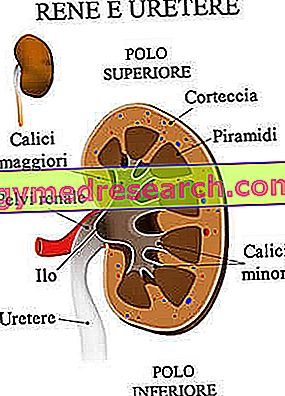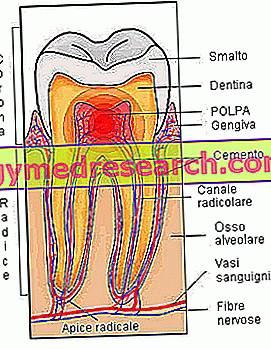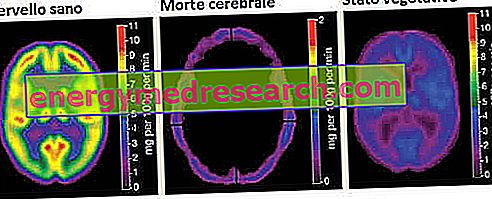Generality
The ureter is an equal and symmetrical tubular canal, which connects each kidney to the bladder.
About 28-30 centimeters long and with an average diameter of about 6-8 millimeters, it has three portions: abdominal, pelvic and bladder.

Figure: anatomy of the kidney. Thanks to the image, the reader can appreciate the precise location of the renal pelvis, the larger calyxes and all those other structures mentioned in the article.
The abdominal portion constitutes the first section of the ureteral canal, after its birth at the level of the renal pelvis.
The pelvic portion represents the second section, the one with origin at the level of the pelvic cavity and with term in correspondence of an antero-medial curvature of the ureteral canal.
Finally, the bladder portion is the last section, leading to the ureteral orifice, inside the bladder.
The function of the ureters is to transport urine, produced by the kidneys, into the bladder.
Brief anatomical reference of the urinary tract
The elements that make up the urinary tract are the kidneys and the urinary tract .
The kidneys are the main organs of the excretory apparatus . In number of two, they reside in the abdominal cavity, on the sides of the last thoracic vertebrae and of the first lumbar vertebrae, they are symmetrical and possess a shape that resembles that of a bean.
The urinary tract, instead, form the so-called urinary tract and present, from top to bottom, the following structures:
- The ureters, whose description is up to this article.
- The bladder . It is a small hollow muscular organ, which accumulates urine before urination. It resides in the pelvic cavity.
- The urethra . It is the channel, of tubular form, which connects the bladder to the so-called urinary meatus (or external urethral orifice) and which serves mainly to expel urine.

What is the ureter
The ureter is an even conduit, symmetrical and fairly large in diameter, which connects each kidney to the bladder and which carries urine to be expelled inside the urine.
In other words, the ureter is a drainage tube, which favors the advancement of urine towards the structures responsible for the urination process.
Obviously, from the right kidney, originates the so-called right ureter and, from the left kidney, the so-called left ureter.
Anatomy
Originating from the renal pelvis (abdomen) and ending at the level of the bladder (pelvic cavity), the ureter has an average length of about 28-30 centimeters and an average diameter of about 6-8 millimeters (NB: the diameter varies considerably to depending on the point considered).
The anatomy experts recognize three portions in the ureter: the abdominal portion, the pelvic portion and the bladder portion .
In addition to the course of the ureters, in this chapter, the reader will be able to find information concerning their anatomical relationships, their histological structure, their blood supply and their innervation.
Brief review of the concepts: sagittal plane, medial position and lateral position
In anatomy, medial and lateral are two terms with the opposite meaning. However, to fully understand what they mean, it is necessary to take a step back and review the concept of the sagittal plan.

Figure: the plans with which the anatomists dissect the human body. In the image, in particular, the sagittal plane is highlighted.
The sagittal plane, or median plane of symmetry, is the antero-posterior division of the body, a division from which two equal and symmetrical halves are derived: the right half and the left half. For example, from a sagittal plane of the head derive a half, which includes the right eye, the right ear, the right nasal nostril and so on, and a half, which includes the left eye, the left ear, the left nasal nostril etc.
Returning to the medial-lateral concepts, the word media indicates a relationship of proximity to the sagittal plane; while the word side indicates a relationship of distance from the sagittal plane.
All anatomical organs can be medial or lateral with respect to a reference point. A couple of examples clarify this statement:
First example. If the reference point is the eye, it is lateral to the nasal nostril of the same side, but medial to the ear.
Second example. If the reference point is the second toe, this element is lateral to the first toe (toe), but medial to all the others.
ABDOMINAL PORTION
Called that because it takes place at the level of the abdomen, the abdominal portion of a ureter is its initial (or proximal) section
The starting point coincides with the so-called renal pelvis (or renal pelvis ). Located inside the renal hilum, the renal pelvis is that area of each kidney, which receives urine from the larger calyxes . In fact, it marks the passage between the kidneys and the urinary tract.
Where the ureter is born, the renal pelvis narrows, giving rise to the so - called uretero-pelvic junction .
From the uretero-pelvic junction, the ureter follows a downward path, which leads it to transit anteriorly to the large psoas muscle and to always remain in a retroperitoneal position, until it enters the pelvis.
When entering the pelvis (area after which the pelvic portion begins), the ureter passes near the common iliac arteries .
Relationships of the abdominal portion
The abdominal portion of the two ureters borders from top to bottom:
- Laterally (ie on the external side), with the inferior pole of the kidney, the ascending colon (right ureter) and the descending colon (left ureter).
- Dorsally, with the large psoas muscle, the genitofemoral nerve and the common iliac arteries.
- Medially (ie on the inner side), with the inferior vena cava (right ureter), the internal spermatic vein (left ureter), the so-called orthosympathetic chain and the lumbar lymph nodes.
- Anteriorly, with the parietal peritoneum of the posterior wall of the abdomen, the spermatic vessels (only in the male) and the ovarian vessels (only in the female).
PELVIC PORTION
The pelvic portion of each ureter is the section that takes place in the pelvic cavity.
First, it runs along the pelvic side walls; in a second moment, in this case at the level of the ischial spines, it undergoes a curvature in an antero-medial direction, which leads the ureteral duct to assume a slightly transverse position with respect to the bladder.
The anteromedial curvature of the ureters is essential to avoid the reflux of urine, from the bladder to the kidneys.
Relationships of the pelvic portion
In both sexes, the pelvic portion of the two ureters establishes slightly different ratios, since the pelvic anatomy of man and woman is different.
- Later, it borders on the hypogastric vessels (both in men and women).
- Medially, it is related, from top to bottom, with the rectum (both sexes), the pelvic fascia covering the levator ani muscle (only in humans), the vas deferens (only in humans), the margin lateral bladder (in men only), the seminal vesicle (only in men), the ovarian dimple (only in women), the infundibulum of the uterine tube (only in women), the uterine artery (only in women) and the wall of the bladder bottom (only in women).
BLOOD PORTION
The bladder portion of each ureter is the section that communicates with the bladder.
10-15 millimeters long, it crosses the bladder wall obliquely until it reaches the bladder cavity. Here, it forms an opening that takes the name of ureteral orifice .
The oblique crossing of the bladder wall is the result of the anteromedial curvature, which undergoes the pelvic portion of each ureter.
The maintenance of the oblique disposition contributes to preventing the reflux of the urine from the bladder towards the kidneys.
TONACHE AND EPITHELI OF THE URETER: A LITTLE HISTOLOGY
The wall of each ureter has three coats, which, from the inside to the outside, are: the mucous membrane, the fibromuscular frock and the adventitious frock .

Figure: thanks to the image, the reader can appreciate the anteromedial curvature of the ureters, at the level of their pelvic portion.
Without going into too much detail, the mucous membrane has mainly transition epithelium, an elastic cellular lining typical of the urinary tract (so much so that experts call it also urothelium ).
The fibromuscular robe contains mostly smooth muscle cells, interposed by bundles of connective tissue.
Finally, the adventitia tunic includes loose connective tissue, characterized by elastic fibers. Its presence in the bladder portion is considerable.
BLOOD SPRAYING OF THE URETERS
The arterial vessels of each ureter derive from the renal, genital and hypogastric arteries.
In the case:
- The renal artery takes care of the arterial blood supply of the upper part of each ureter.
- The genital artery is concerned with the arterial circulation of the median tract of each ureter. Derivation of the abdominal aorta, the genital artery takes the specific name of testicular artery, in man, and of ovarian artery, in the woman.
- The hypogastric artery takes care of the arterial blood supply of the lower part of each ureter. Also known as the internal iliac artery, the hypogastric artery has numerous branches, all of which participate in the ureteral blood supply. Table. The branches of the hypogastric artery, which participate in the blood supply of the lower part of the ureters.
- The upper bladder artery
- Uterine artery (only in women)
- The middle rectal artery
- Vaginal arteries (in women only)
- The inferior bladder artery (only in humans)
As for the venous vessels, they flow from top to bottom:
- In the venous network of the adipose capsule of the kidney
- In the renal vein
- In the spermatic venous plexus (only in men) and in the ovarian venous plexus (only in women)
- In the branches of the hypogastric vein
INNERVATION OF THE URETERS
The nerves that innervate each ureter are sympathetic and parasympathetic nerve fibers, which derive from the renal, testicular (in men) / ovarian (in women) and bladder plexuses .
The sympathetic fibers are part of the sympathetic nervous system and have an inhibitory action against urination; the parasympathetic fibers, on the other hand, are part of the parasympathetic nervous system and promote urination.
Deepening on the sympathetic nervous system and parasympathetic nervous system
Together, the sympathetic nervous system and the parasympathetic nervous system constitute the so-called vegetative (or autonomous ) nervous system, which performs a fundamental action of controlling involuntary bodily functions.
The sympathetic nervous system tends to be active during an emergency situation. Not surprisingly, doctors claim that he presides over the "attack and escape" adaptation system.
In contrast, the sympathetic nervous system tends to become active in situations of rest, rest, relaxation and digestion. For this reason, doctors consider it the basis of the "rest and digestion" adaptation system.
* Please note: in the medical field, the word "plexus" is used both when talking about blood vessels and when talking about nerves. A vascular plexus is definitely different from a nerve plexus: the first is a reticular formation of arterial (or venous) vessels intertwined, while the second is a reticular formation of nerves.
Functions
Each ureter has the important function of leading the urine out of the kidneys into the bladder.
Urethra diseases
Among the problems that can affect ureters, one of the most relevant and widespread is the so-called ureteral calculosis .
Similar to renal and bladder calculosis, ureteral calculosis is a pathological condition of the urinary tract, characterized by the presence of small mineral aggregates, inside one or both ureters. These mineral aggregates (commonly called calculations ) derive from the precipitation of some substances contained in the urine and, following their accumulation, they can obstruct the ureters that contain them.

Figure: ureteral calculi, kidney stones and bladder stones.
With the obstruction of one or both ureters, the flow of urine is inadequate and symptoms such as pain during urination and / or hematuria (blood in the urine) appear.
Within the ureteral conduit, there are sections that are most affected by ureteral calculosis, due to their particular narrowness (in diameter). These sections are: the uretero-pelvic junction, the last section of the abdominal portion and the portion of the ureter that joins the bladder (bladder portion).



